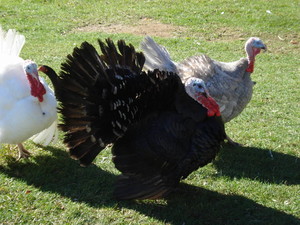17 Feb Tue 2009
Maple Sugaring Commences!
For the past two days we have been trekking back and forth from the woods, hauling in planks to get across small brooks, hauling in tapping supplies, and hauling back our two children when they are finally ready to go inside.
We have a series of photos to share from the past two days. The photo spread will take you from the arrival of our new sugaring equipment through to the tapping of the trees. We will be adding more as we fire up the new evaporator for the first time. I made a pretty cool device that will allow us to continually add sap to the boiling pan and I will add a photo of that later on. It seems that the camera is on strike from being dropped in the snow...
Here is the new gear arriving from New Hampshire.

And here we have it all unloaded out behind the barn. We have used a combination of aluminum buckets and milk jugs in our previous experience making maple syrup, but with our new evaporator we will need LOTS more sap to keep up. So, as you may recall from a prior post, we are resorting to one of the most useful farm implements all around: the 5 gallon pail! We'll be adding 50 more (for a total of about 100) taps this year. Also, the buckets will be nice as we can empty them once every other day instead of the twice daily routine with our smaller pails and jugs. It is pretty far out to the woods, afterall.
You can see that we have the evaporator just about assembled in this shot.


The next step was tapping the trees. We still have a bit of snow on the ground out in the woods, and there are also lots of hidden "water holes" beneath these patches of show. Look out! There goes a boot!

My son has taken to using the brace and bit. If we're not watchin him, he'll have every tree in the area tapped. I wonder how oak syrup would taste?

Here is Erica carrying the tubing. We're using short pieces of tubing to connect the spouts (technically called "spiles") to the buckets. In the future, we might run tubes directly from the trees out of the woods to large gathering drums. We would start tapping the trees higher up, about 6 feet, and then gravity would help move the sap out of the woods as we slope down to the drums. We're not sure that we want tubing running all through the woods, though. I guess we will decide on this once we've determined the relative fun-to-labor ratio of hauling this stuff out by hand this year.

Here is a close up of a tapped tree. On a good tapping day, you should be able to see the sap start dripping out. If you look closely, you can see it starting to run out of the hole.

Here is shot of several trees tapped alongside of our stream. This summer the stream swelled significantly during a series of storms. It was well up beyond the buckets in the photo.

And here we are after working hard at enjoying a hobby. My son snapped this one whilst the camera was still with us.

Part two to follow. Stay tuned...

